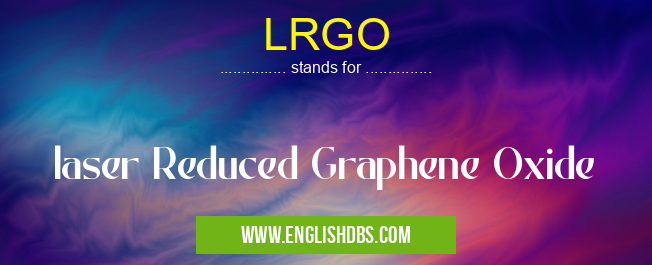What does LRGO mean in UNCLASSIFIED
LRGO stands for Laser Reduced Graphene Oxide. It is a type of graphene oxide that has been reduced using a laser. Graphene oxide is a form of graphene that contains oxygen atoms, which makes it hydrophilic (water-loving). Laser reduction removes the oxygen atoms from the graphene oxide, making it hydrophobic (water-repelling).

LRGO meaning in Unclassified in Miscellaneous
LRGO mostly used in an acronym Unclassified in Category Miscellaneous that means laser Reduced Graphene Oxide
Shorthand: LRGO,
Full Form: laser Reduced Graphene Oxide
For more information of "laser Reduced Graphene Oxide", see the section below.
Properties of LRGO
- High electrical conductivity: LRGO has a high electrical conductivity, which makes it a good conductor of electricity.
- High thermal conductivity: LRGO also has a high thermal conductivity, which makes it a good conductor of heat.
- Mechanical strength: LRGO is a strong material, which makes it resistant to tearing and breaking.
- Flexibility: LRGO is a flexible material, which makes it easy to bend and shape.
- Optical properties: LRGO has unique optical properties, which make it a good absorber of light.
Applications of LRGO
LRGO has a wide range of potential applications, including:
- Electronics: LRGO can be used in electronic devices, such as transistors and solar cells.
- Energy storage: LRGO can be used in energy storage devices, such as batteries and capacitors.
- Sensors: LRGO can be used in sensors, such as gas sensors and biosensors.
- Catalysis: LRGO can be used as a catalyst for chemical reactions.
- Biomedical applications: LRGO can be used in biomedical applications, such as drug delivery and tissue engineering.
Essential Questions and Answers on laser Reduced Graphene Oxide in "MISCELLANEOUS»UNFILED"
What is LRGO (laser Reduced Graphene Oxide)?
LRGO is a graphene oxide (GO) material that has been reduced using a laser. This process removes oxygen atoms from the GO structure, resulting in a graphene-like material with improved electrical and thermal properties.
How is LRGO produced?
LRGO is produced by exposing GO to a laser beam. The laser's energy breaks down the oxygen-containing functional groups on the GO surface, reducing it to a more graphene-like structure.
What are the advantages of LRGO over GO?
LRGO offers several advantages over GO, including:
- Improved electrical conductivity
- Enhanced thermal conductivity
- Increased mechanical strength
- Reduced oxygen content
What are the applications of LRGO?
LRGO has potential applications in various fields, such as:
- Electronics and optoelectronics
- Energy storage and conversion
- Sensors and biosensors
- Biomedical engineering
How does LRGO compare to other graphene materials?
LRGO differs from other graphene materials in its production method and properties. Compared to chemical reduction methods, laser reduction offers better control over the reduction process and results in a more uniform material. LRGO typically has higher electrical conductivity and thermal conductivity than GO, but lower than pristine graphene due to the presence of some residual oxygen atoms.
Final Words: LRGO is a promising material with a wide range of potential applications. Its unique properties make it a good candidate for use in electronic devices, energy storage devices, sensors, catalysts, and biomedical applications.
